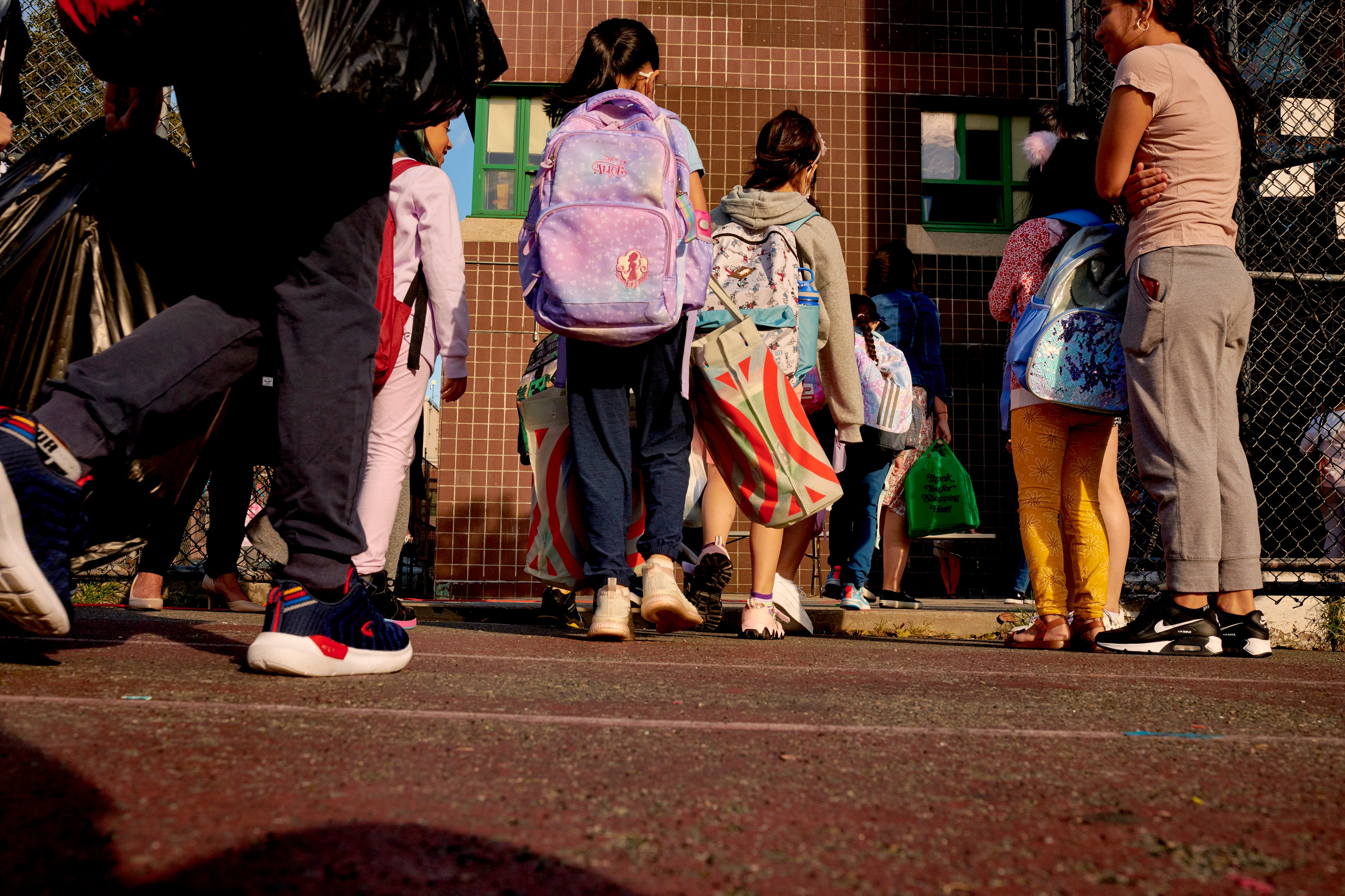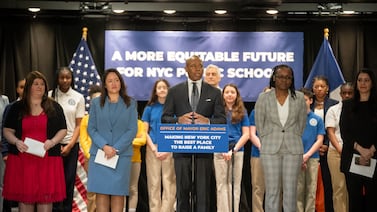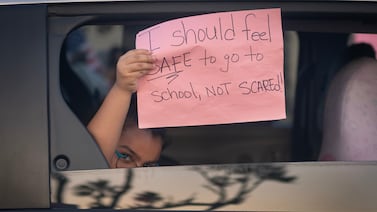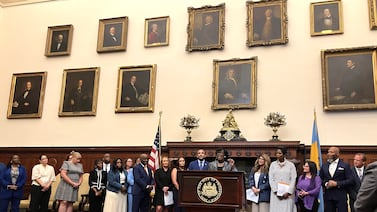Sign up for Chalkbeat New York’s free daily newsletter to keep up with NYC’s public schools.
More New York City students than at any point in the past five years say kids in their schools regularly bully each other, newly released 2024 school survey results show.
More than half of the roughly 355,000 middle and high school students who responded to the city school system’s annual survey earlier this year said their classmates sometimes or often bullied, harassed, or intimidated each other last school year – up from 44% in 2019, the first year for which citywide survey numbers are available.
The rise in student reports of bullying comes as city schools confront a swirl of social challenges including the lingering effects of the pandemic, cyberbullying, social media, and global tumult such as the Israel-Hamas war and mass migration into New York City.
The rising student bullying numbers are among several notable trends from the latest annual questionnaire, which also reached roughly 66,000 teachers and over 400,000 parents and guardians this year.
For educators, the survey suggests that sweeping new curriculum mandates are trickling down into classrooms, with teachers reporting less influence over selecting curriculum, but more coherence in how their schools are approaching instruction. And nearly a third of city teachers reported dissatisfaction with the schools chancellor – a figure that’s nearly doubled since 2019.
Parents, meanwhile, continued to express a desire for more extracurricular and after-school options.
Here are five takeaways from the 2024 school survey. You can access the full results by navigating to the Education Department’s 2024 survey page and clicking on the “results page” link.
Cyberbullying, discrimination on the rise
In all five questions on the 2024 survey involving bullying and harassment, students reported worse outcomes than in previous years.
Among the most notable changes: Roughly 43% of students reported seeing regular bullying and harassment online this year, compared to 35% in 2019.
Educators across the city have sounded the alarm about the effects of social media and online bullying spilling into classrooms. One Queens school administrator threatened last fall to suspend students for following an Instagram account that posted vulgar and insulting comments about students.
Increasing awareness of the harms of online harassment has also played a role in some schools’ decisions to ban cell phones during the school day, and in the city’s debate over instituting a systemwide ban.
More students also report seeing classmates bullied over their backgrounds, with 40% of students seeing harassment based on race, ethnicity, religion, or immigration status, up from 30% in 2019.
The reports came during a school year marked by explosive conflicts over the Israel-Hamas war and the continued arrival of tens of thousands of migrant students – some of whom expressed concerns that their immigration status made them targets.
As in past years, girls – and Black girls in particular – reported the highest rates of bullying and harassment.
Education Department spokesperson Jenna Lyle said, “Bullying has absolutely no place in our school communities.” She pointed to a citywide Respect for All initiative that provides professional development for school staff to deal with bullying and designates a liaison in every school.
Teacher dissatisfaction with the chancellor is up
Roughly 32% of teachers said they were dissatisfied with schools Chancellor David Banks – up from 30% last year and 17% in 2019, when former Chancellor Richard Carranza was at the helm.
A plurality of teachers, 44%, reported that they were satisfied with the chancellor, while 24% said they didn’t know.
It’s difficult to know exactly what’s driving the rise in dissatisfaction. Banks has launched several major curriculum initiatives that have forced big changes in how schools teach reading and algebra, drawing mixed responses from educators.
Earlier in Banks’ tenure, he and Mayor Eric Adams presided over deeply unpopular budget cuts as federal pandemic aid dried up, though officials replaced much of the expiring funding last year.
Teacher dissatisfaction with the schools chancellor has swung dramatically in previous years as well. It dropped from 43% to 18% between 2014 and 2015 when Carmen Fariña took over from Dennis Walcott.
Lyle, the Education Department spokesperson, said Banks is making “needed changes” to the school system, but said he is “committed to supporting staff” during those changes. “95% of families are satisfied with the education their children are receiving and teachers report high levels of satisfaction with their work, their schools, and the professional development they are receiving,” she added.
Effects of curriculum changes take hold
Rising dissatisfaction with the chancellor may not be the only impact of the big curriculum changes.
Teachers, particularly those in elementary schools, where officials have mandated superintendents to choose one of three pre-approved literacy curriculums, report having less influence over selecting curriculum in their schools, with 67% saying they have some or a great deal of influence, down from 71% last year. Only 58% of elementary teachers said they had influence over choosing curriculum materials.
On the other hand, teachers reported more “instructional coherence,” with 81% saying that when their school started a new program, they followed up to make sure it was working, up three percentage points from last year.
Parents continue to crave more extracurricular options
When asked which improvement they most wanted at their kids’ schools, the largest group of parents asked for stronger enrichment programs like clubs and after-school activities.
That tracks with past years. Stronger enrichment programming has been the top request of parents for years, with smaller class sizes next in line. In 2024, 24% of parents said more enrichment programs were their top priority, while 15% said smaller class sizes. In 2017, 24% of families chose enrichment programs, while 21% chose class sizes.
Enrichment programs can be particularly difficult for small schools to offer because they are funded on a per-pupil basis. As enrollment has shrunk, the number of tiny schools has also grown.
Average class sizes for elementary, middle, and high schools are down slightly compared to 2019, though they’re up compared to 2022. The 2022 state class size law will require the city to continue significantly reducing class sizes in the coming years.
Mental health, classroom behavior remain challenges
Educators across the city and country have confronted growing challenges with student mental health and behavior in the wake of the pandemic, and those issues remain challenges, the survey data indicates.
This year, 68% of teachers said their students regularly do their work when they’re supposed to, down from 69% last year and from 75% in 2022 and 2019. Roughly 77% of teachers said adults in their buildings had access to mental health support, down two percentage points from last year, and eight percentage points compared to 2022.
Michael Elsen-Rooney is a reporter for Chalkbeat New York, covering NYC public schools. Contact Michael at melsen-rooney@chalkbeat.org







